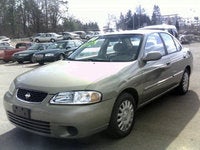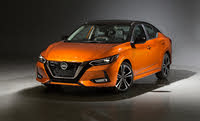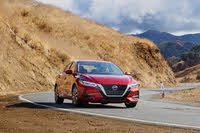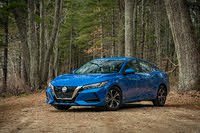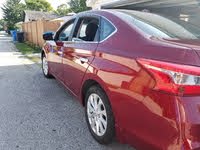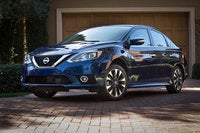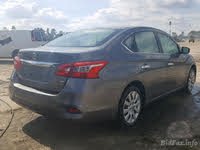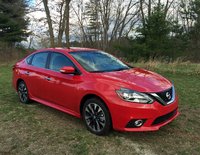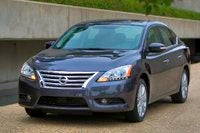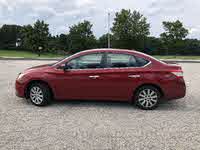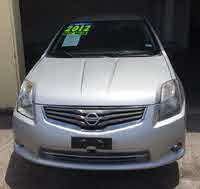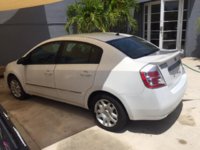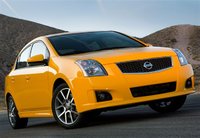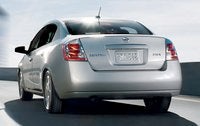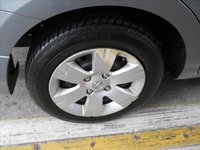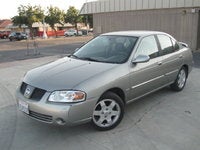Nissan Sentra Model Overview
About the Nissan Sentra
Available Now
The Nissan Sentra compact car delivers good handling and a roomy interior for a car its size and represents a solid value for prospective buyers. Geared toward single drivers, young families, and budget-oriented buyers, the Sentra debuted in 1982, replacing the Datsun 210 in the automaker's lineup. In fact, the Sentra appeared at a pivotal time for the automaker, which was in the process of changing its name from Datsun to Nissan. As a result, the Sentra became the first car badged solely as a Nissan.
Throughout the years, the Sentra has evolved from a subcompact car to a compact car with a large cabin, causing the EPA to classify it as a midsize vehicle. Until 2007, the Sentra occupied the entry-level slot in Nissan's lineup. However, the Versa now occupies that slot, relegating the Sentra to a sort of no-man's land, as the Versa offers a better option for a compact, while the Altima makes a better choice for a midsize sedan. Other vehicles in the Sentra's very competitive automotive segment include the Ford Focus, the Honda Civic, the Hyundai Elantra, the Mazda3, and the Toyota Corolla, among many others.
Over the years, Nissan has offered the Sentra in a number of body styles, including coupes, wagons, and hatchbacks. More recently, the Sentra has been available only as a sedan. Currently in the midst of its sixth generation, the Sentra received a mid-generation refresh in 2010, which included exterior updates, additional options packages, and a new 2.0 SR trim. It joined the Sentra's other existing trims, including the Base 2.0, the 2.0 S, the 2.0 SL, the SE-R, and the SE-R Spec V. For 2011, Nissan extended such standard safety features as electronic stability control, traction control, and antilock brakes to all trims, including the Base 2.0.
A 2.0-liter four-cylinder engine developing 140 hp powers all 2.0 trims. It links to either a six-speed manual transmission or a continuously variable transmission (CVT). The EPA estimates fuel economy numbers for the 2.0-liter engine at 26/34 mpg with the CVT and 24/31 with the manual shifter. The SE-R gets more power, in the form of a 2.5-liter four-cylinder, which puts out 177 hp. It comes only with the CVT and posts fuel economy numbers of 24/30 mpg. At the top of the line, the SE-R Spec V gets a modified version of the 2.5-liter engine, developing 200 hp. It mates to the six-speed manual, and manages fuel economy numbers of 21/28 mpg.
Most reviewers consider the Sentra a good but unexciting entry in the compact car segment. While the Sentra borrows some of its exterior styling cues from its up-segment brothers like the Maxima, it underwhelms in the power department, and its suspension remains too stiff for some owners and reviewers. However, the cabin offers plenty of headroom and legroom, and the CVT receives generally good marks. The Sentra also delivers good fuel economy and an affordable pricetag.
With its mid-generation refresh fairly recent, the Sentra will likely receive only minor updating for the next year or two. However, Nissan may soon introduce an electric-powered or hydrogen fuel cell version of the Sentra, although the automaker has no immediate plans to introduce a hybrid version.
Model History
The Nissan Sentra began its production run in Japan in the mid-1960s, where it was known as the Sunny. After several incarnations in Japan as a rear-wheel-drive vehicle, the first front-wheel-drive Sunny, known internally as the B11 series, debuted in Japan in 1982. This also was the first year Nissan exported the Sunny to the U.S. market, where it was re-badged as the Sentra for the 1983 model year. The Sentra pre-dated the front-wheel-drive version of its primary competitor, the Toyota Corolla, by several years. In addition, it was the first Nissan built in the U.S., at the automaker's new automotive plant in Smyrna, Tenn.
Nissan offered the first-generation U.S. version of the Sentra in a variety of body styles, including a four-door sedan, a two-door coupe, a two-door hatchback, and a four-door wagon. The Sentra sat on a wheelbase of 94.9 inches, with an overall length of 163 inches.
In the Sentra's early years, power came from either a 74-hp, 1.5-liter four-cylinder engine or an 85-hp, 1.6-liter four cylinder. A four-speed manual came standard, although buyers could upgrade to a three-speed automatic. In the following years, Nissan would add an optional four-speed automatic. The Sentra featured a four-wheel independent suspension, with front disc and rear drum brakes as standard equipment. It sat on 13-inch wheels.
One of the Sentra's big selling points during its first few years was its fuel economy. In early commercials, the automaker promoted the Sentra's impressive numbers of 43/58 mpg, which made it the most fuel-efficient car available at the time.
The second-generation Sentra, internally referred to as the B12 series, appeared in U.S. showrooms for the 1986 model year. Body styles again included sedans, coupes, hatchbacks, and wagons, at entry-level E, mid-level XE, and upper-level GXE trim levels, as well as new sport-oriented SE coupe. The Sentra sat on a 95.7-inch wheelbase, an increase of only .08 inches over the previous generation. Overall length depended on the body style, ranging from 162.4 inches for the hatchback to 172.2 inches for the wagon.
Powerplants included an 84-hp, 1.6-liter four-cylinder engine, although in the late '80s Nissan would make the 90-hp, 1.6-liter four cylinder the sole available engine. The Sentra sat on an upgraded four-wheel independent suspension, with four-wheel disc brakes and all-wheel drive available for some trims.
In 1989, the Sentra received some minor exterior tweaks, including revised fenders and taillights. In 1990, electrically retractable front shoulder belts were added to the standard equipment list.
The third-generation Sentra, called the B13 series internally, debuted in 1992 with a new 110-hp, 1.6-liter four-cylinder engine. Wheelbase for the Sentra remained the same, at 95.7 inches, while overall length was standardized at 170.3 inches. Nissan dropped the hatchbacks and wagons from the trim lineup and added a new upper-level Limited Edition trim, which along with the GXE came equipped with power windows, door locks, and mirrors, as well as an optional sunroof and optional alloy wheels.
In addition to the Limited Edition, a sporty two-door SE-R trim joined the lineup for the third generation. It came equipped with a 140-hp, 2.0-liter four-cylinder engine, as well as four-wheel disc brakes, an independent suspension with MacPherson struts, and a viscous limited-slip differential, which helped deliver sporty handling.
For the Sentra's fourth generation (the B14 series), which appeared in showrooms in 1995, Nissan updated the suspension, adding a torsion-beam configuration in the rear, and stretched the wheelbase to 99.8 inches. Overall length remained about the same as the previous generation at 170.1 inches. The fourth-generation Sentra displayed a rounded, more aerodynamic exterior design, with a notchback design element behind the cabin, where the rear window meets the trunk lid. Nissan spun the two-door Sentras off into their own line, using the 200SX designation, leaving the Sentra as a four-door sedan body style only.
Nissan offered the fourth-generation Sentra in Base, XE, GXE, and GLE trim levels, with dual front airbags as standard equipment. Interior space increased dramatically, thanks to the longer wheelbase. Power came from a 115-hp, 1.6-liter four-cylinder matched with either a five-speed manual transmission or an optional four-speed automatic. The automaker also offered such options as leather upholstery, a moonroof, and antilock brakes for the GXE and GLE trim levels only. All Sentra trims continued to ride on 13-inch wheels.
The Sentra received a minor exterior refresh in 1998, which included a new mesh grille and new taillights, and the GXE and GLE trims received an upgrade to 14-inch wheels. Nissan updated the Sentra's grille again in 1999 with a new oval design.
The fifth-generation Sentra (the B15) debuted in 2000 with a larger platform and a new exterior design to usher in the 21st century. The Sentra's wheelbase increased to 99.8 inches, while overall length grew to 177.5 inches, pushing the Sentra from the subcompact to the compact car segment, while the Altima moved up to the midsize sedan segment. Updates include a sportier exterior design with body-colored bumpers and grille, a stiffer platform for improved handling, and a roomier cabin with higher-quality materials and components, as well as a more extensive options list.
A new 126-hp, 1.8-liter four-cylinder engine provided base power for the XE and GXE trims, while the sport-oriented SE received a 145-hp, 2.0-liter four cylinder, as well as larger tires and brakes, a rear spoiler, and side sills. Production for the Sentra shifted from Tennessee to Mexico, as the Smyrna plant was reconfigured to produce the Xterra.
For 2002, Nissan dropped the SE trim from the lineup and brought back the sport-oriented SE-R and the new SE-R Spec V trims to the Sentra lineup. Both came equipped with a 2.5-liter DOHC four-cylinder engine generating 165 hp in the SE-R and 175 hp in the Spec V. The SE-R featured a sport suspension, larger brakes, a rear spoiler, and 16-inch wheels, while the Spec V rode on a stiffer racing suspension and 17-inch tires and came equipped with sport seats.
In 2004, Nissan rejiggered the Sentra's lineup, changing the names of the XE and GXE trims to the Sentra 1.8 and Sentra 1.8S, which reflected the 1.8-liter, 126-hp four-cylinder engine powering both trims. The 1.8S came equipped with power features, remote entry, an eight-way driver's seat, and CD player. The lineup also included a 2.5S, powered by a 165-hp, 2.5-liter four cylinder, while the SE-R and SE-R Spec V retained their same engines and racing-inspired suspensions.
When the Sentra's sixth generation (the B16 series) debuted at the North American International Auto Show in 2006 for the 2007 model year, it again grew in size and relinquished its entry-level spot in Nissan's automotive lineup to the Versa. The Sentra sat on a new platform borrowed from French automaker Renault, with whom Nissan established an alliance in 1999. Wheelbase grew to 105.7 inches, and overall length increased to 179.8 inches, causing the EPA to classify the Sentra as a midsize vehicle.
The sixth-generation Sentra borrowed most of its exterior styling cues from the Maxima, and came equipped with a new 140-hp, 2.0-liter, DOHC four-cylinder engine. Trim levels included the Base, S, and SL, as well as the SE-R and SE-R Spec V, which appeared later in the 2007 model year. Standard features for all trims included power locks and windows, electronic steering, air conditioning, and side airbags, while antilock brakes came standard on all but the Base trim.
The Sentra's mid-generation refresh in 2010 included a new grille inspired by the Altima's, a revised lower fascia, and revamped headlights and taillights. New options included a navigation system and a backup camera.
Used Versions
In 2006, Kiplinger named the Sentra one of the year's Five Best Automotive Values, and noted it had a resale value about equal to the Civic's. Given the Sentra's lower initial cost, it continues to represent a good value for prospective buyers looking for a solid used car. Although the Sentra hasn't always kept up with the competition in such areas as performance and standard features, it delivers a roomy cabin and good fuel economy, and upper-level trims come fairly well-equipped.
Buyers seeking a compact sedan with roomy cabin and good gas mileage, as well as a solid list of standard equipment, will want to look for sixth-generation Sentras built in 2007 or after. Although many owners say the current-generation Sentra could use more power, they like its CVT transmission and generally smooth ride. Sport-oriented SE-R and SE-R Spec V trims remain good options for buyers seeking a sportier ride.
The fifth-generation Sentra, produced from 2000 to 2006, also remains a good option for buyers. With this generation, the Sentra grew up and out of is earlier "cheap car" phase and became a true contender in the compact-car market segment. It featured higher-quality interior materials, when compared with the previous generation, as well as more comfortable seats. In addition, its nearly 100-inch wheelbase helped provide a better ride compared to earlier generations.
Sentra trims produced before 2000 also remain good options for buyers, although the quality of materials drops off compared to later generations. The fourth generation's reconfigured torsion-beam rear suspension helped provide a slightly sportier ride, and the notchback roof design added a distinctive exterior element. For the third generation, which debuted in 1992, Nissan offered upper-level Limited Edition and GXE trims equipped with power windows, doorlocks, and mirrors.
Buyers who seek the Sentra in a hatchback or wagon body style will have to look at trims built before 1992, in the second and first generations. In addition, buyers who seek an affordable used vehicle with good stability and traction might still be able to find some Sentra trims equipped with all-wheel drive, built in the late 1980s.
New Nissan Sentra


Used Nissan Sentra
Nissan Sentra Questions
Are The Alternators Of Nissan Sentras Interchangeable If The Engine Size Is...
I am trying to replace my 2003 Nissan Sentra alternator and its engine size is 1.8. I'm wondering if an alternator from a 2.5 will work.
No Longer Hear A Chime When I Lock The Doors On My 2017 Sentra
Why do I no longer hear a chime when I lock the doors on my 2017 Sentra by pressing the door lock button on the handle?
Will A 2015 2.5L Nissan Sentra Transmission Interchange With A 2008 2.5L Ni...
Would like to know if interchangeable and what all l would need to change out
2013 NISSAN SENTRA TRANSMISSION
What type of transmission is interchangeable with a 2013 nissan sentra? I need to replace it but they are expensive.
Nissan Sentra Manual Transmission Shift Problems
The collette in my shifter blew. I had to replace the shifter assembly. However, I’m still having issues shifting. Namely I can’t shift into reverse. I think my shift control cable is to blame. An...
